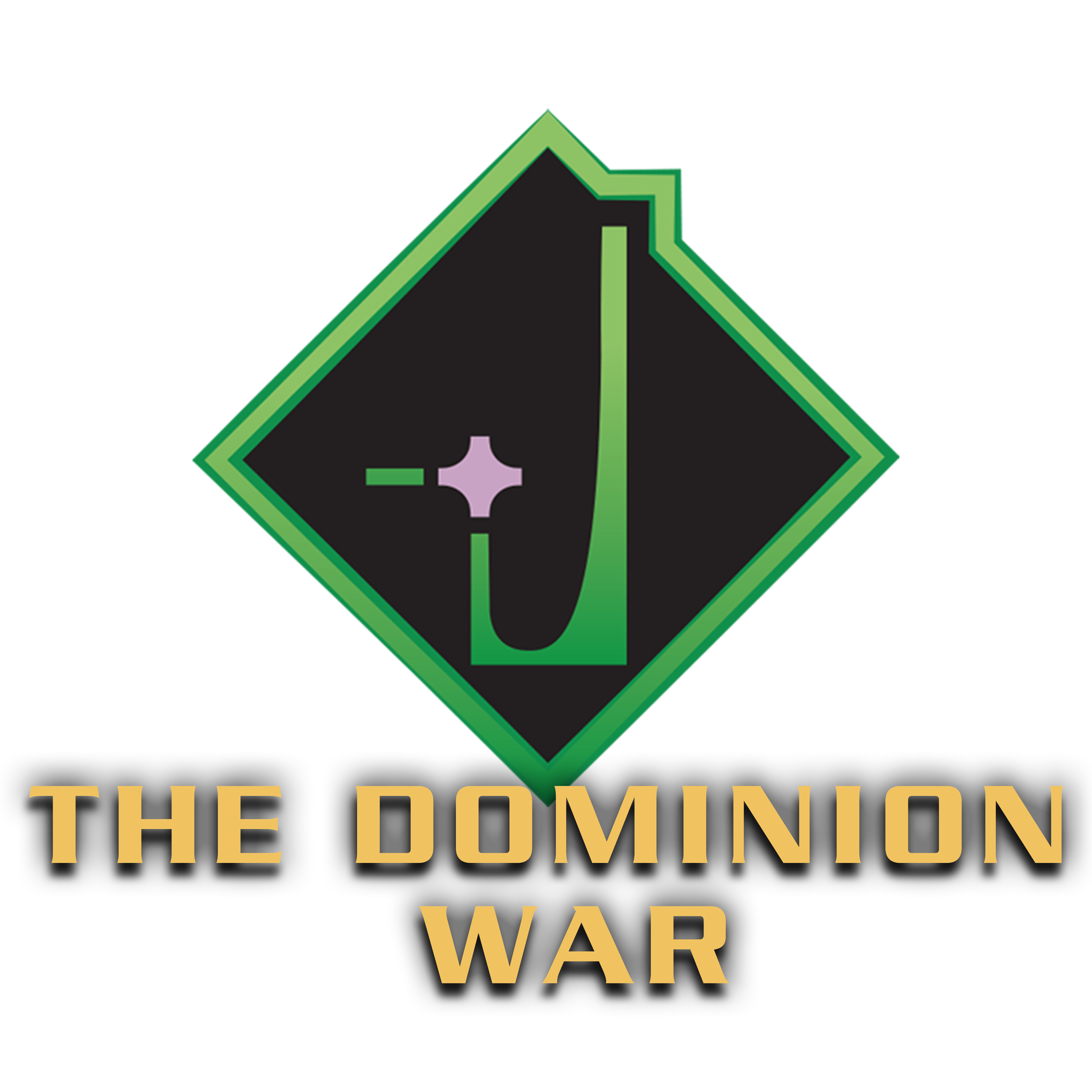 |
"The Dominion has endured for over two thousand years, and will continue to endure long after the Federation has crumbled into dust."
-- Weyoun 4
Established in the Gamma Quadrant thousands of years ago, The Changelings rule as gods, controlling their forces with their Vorta Commanders and fearsome Jem’Hadar soldiers. The discovery of the Bajoran Wormhole has brought the Dominion into conflict with the much younger civilizations of the Alpha Quadrant. Take control of Dominion, venture through the wormhole and establish your place as the dominant civilization of the Galaxy..
|
| Setting Up and integrating the Dominion War Expansion into Your Games |
|
First, to integrate The Dominion into your games of Star Trek: Ascendancy. Shuffle the 20 new Exploration Cards into your Exploration Deck.
|
|
Set The Great Link system, home world and starting location of The Dominion, aside and the Bajor-Idran Wormhole System and now there is a choice to make. You can either ignore the Gamma Quadrant by setting the Bajor-Idran Wormhole System and Gamma Quadrant systems to the side and play a normal game of Star Trek: Ascendancy, or as the Dominion player you can elect to start in the Gamma Quadrant! Now let’s show you can start as the Dominion in the Gamma Quadrant.
|
| Gamma Quadrant Setting Up |
|
The Gamma Quadrants systems are marked by the Gamma Quadrant symbol on both sides. Keep these separate from Alpha Quadrant Systems. Place each player’s Starting System per the rules and then place the Bajor-Idran Wormhole System with the Idran side closest to The Great Link System.
|
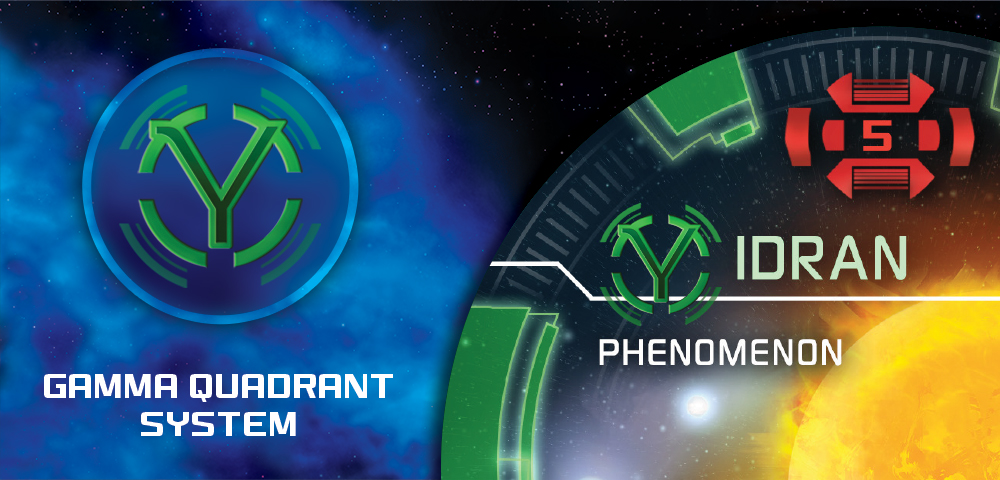
|
|
If no one is playing the Dominion, you can still explore the Gamma Quadrant. Instead of placing it in the centre, set the Bajor-Idran Wormhole System aside. Each time a player draws a Phenomenon, roll the Space Lane Dice. If the result is 4, replace the Phenomenon with Bajor-Idran Wormhole System and connect the space lane to Bajor.
|
| Below: An example of the Bajor/Idran Wormhole System with Dominion Home System. |
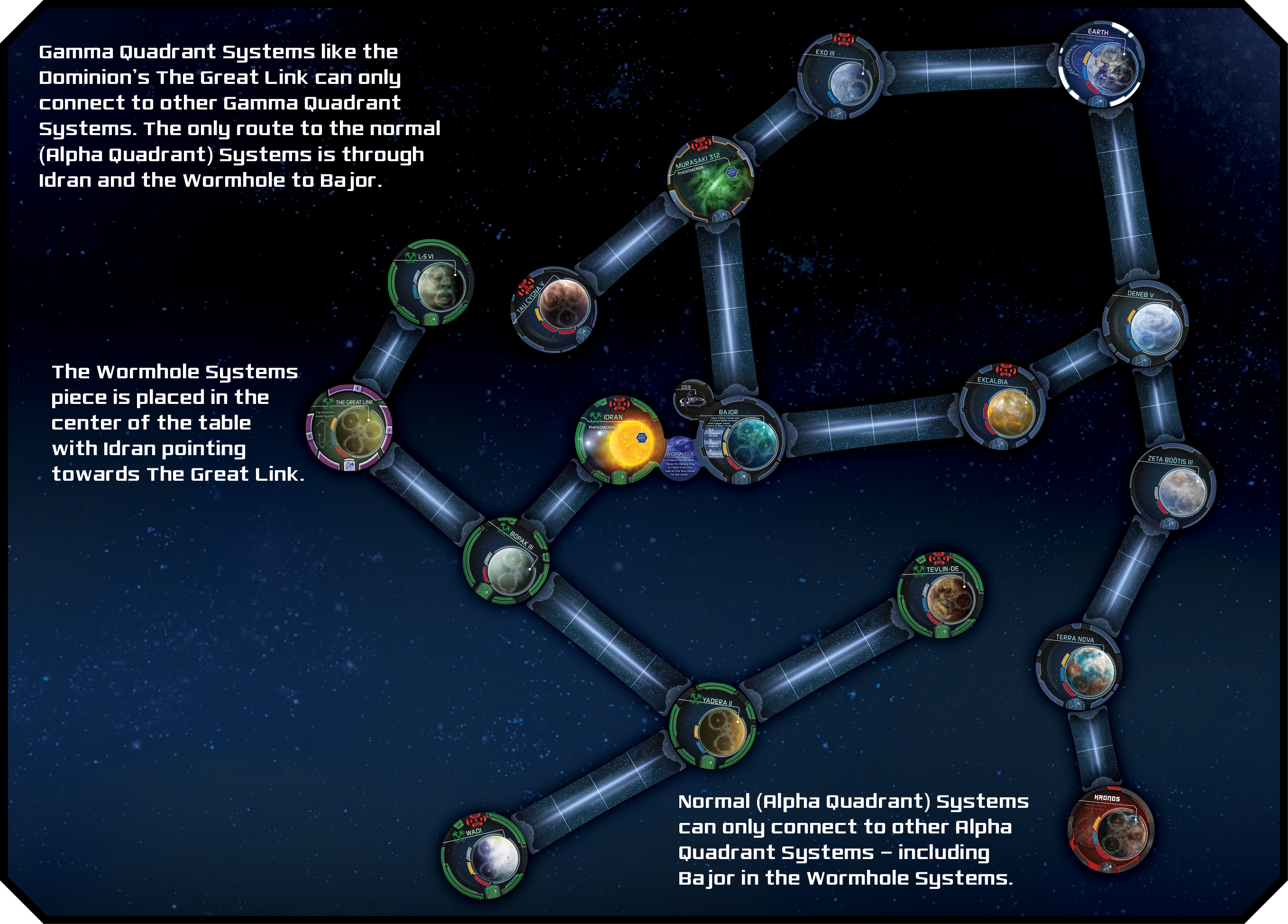
|
|
The Bajor System is unique. It starts as a Warp Capable Independent Civilization per its stats on the system card and unlike most Independent Civilizations it has a Starbase: Deep Space 9. When a player takes control of Bajor they gain control of the Starbase and a Command Token
|
If you have the Cardassian Expansion, remove the Bajor System from the System Discs as the Bajor-Idran - Wormhole System - replaces this system.
|
Lastly, prepare the Gamma Quadrant Systems Stack at the same time that you do the Alpha Quadrant Systems stack. Separate out the Interstellar Phenomenon System Discs from Planetary System Discs, choose two random Planetary System Discs and place them at the top of the shuffled pile of Gamma Quadrant System Discs. Now you are ready to start exploring the Gamma Quadrant!
|
| Exploring the Gamma Quadrant |
Exploring the Gamma Quadrant is identical to the way you’ve previously explored in the Alpha Quadrant. You will place the Space Lane per normal. However, when resolving the discovery of a system connected a Gamma System you must draw your System Disc from the Gamma Quadrant Pile
|
Space Lanes can never connect an Alpha Quadrant system to a Gamma Quadrant System to each other, the only way to reach travel between the two Quadrants is through the Bajor-Idran Wormhole. Lastly players cannot set up Space Lanes and Systems in a way that makes it impossible to connect a system to either Bajor or Idran.
|
| Moving Through the Wormhole |
You cannot move through the Wormhole while in Warp. Ships must exit Warp at Idran or Bajor first. You must Exhaust 1 Command Token to move a Ship or Fleet from one side of the Wormhole to the other. You may always move between the two Wormhole Systems, even if the System on the other side of the Wormhole is held by a Hostile rival. They cannot prevent you from entering the System via the Wormhole. Nor can a rival use Ships in a System to prevent you from leaving that System.
|
Now that we know how to explore the Gamma Quadrant and set up the Dominion in the Game Quadrant let’s take a look at what the Dominion can bring to Alpha Quadrant!
|
| The Dominion Set Up |
The Dominion’s Founders are changeling and shapeshifters and they can take on many different forms and infiltrate other planets and races. At the start of the game, in addition to the normal setup, place Five Infiltrators on The Great Link. You can send these out to study other races and prepare the way for their invasion. The Dominion Player may exhaust two Command Tokens to move them to Any System on the board from “The Great Link”. They may use a Command Token to move to an Adjacent System to their own or to return to “The Great Link”.
|
The Dominion has many advancements that allow them to perform actions in systems that have Infiltrators. For example, False Orders lets you use your own Command Tokens to move rival ships in orbit around systems that have an Infiltrator as if they were your own ships. You can use this to move a rival’s entire fleet out of its defensive position above a planet, into a hazardous system, or even take an unprepared fleet into an ambush of your own! Research these Advancements and use them to get the upper hand over your rivals.
|
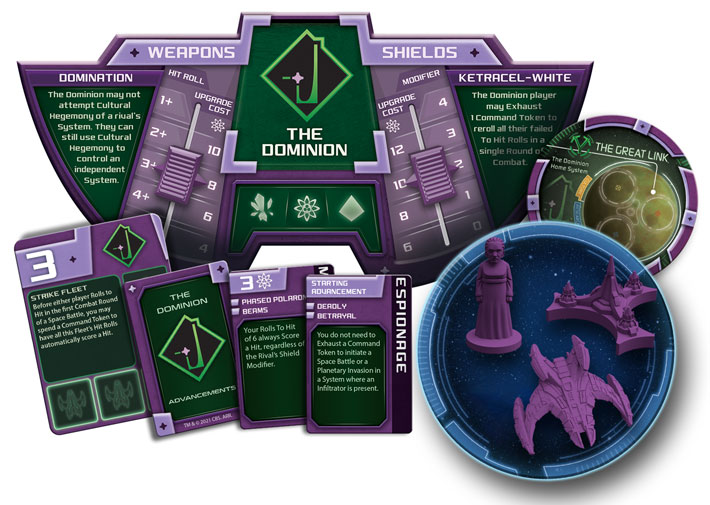 |
| Ketracel-White |
The Dominion makes extensive use of their Jem’Hadar soldiers in war. They keep them loyal through the use of Ketracel-White, a substance that they need to keep them alive. Through their dependence on this, the Founders ensure the loyalty of the Jem’Hadar.
|
With the Ketracel-White rule, you can spend a Command Token to re-roll failed To Hit rolls in a single round of combat in a Space Battle or Planetary Invasion. You can do so in any player’s turn and in each round of combat in a battle or invasion. If you are clever, you can use Ketracel-White to make a devastating attack on a rival or inflict heavier casualties on an attacking rival.
|
| Domination |
The Dominion much prefers cowed subjects rather than allies. They come largely as conquerors and who impose their vision of order on the universe and bring all civilizations under its control. The Dominion cannot attempt to use Cultural Hegemony on a rival- controlled System. They can still use Cultural Hegemony on Independent Systems, however.
|
| Dominion Tactics |
With the Jem’Hadar, the Dominion have access to incredibly powerful soldiers. Many of their advancements give you more Command Tokens you can use to boost your damage output through Ketracel-White. You also have Infiltrators to sabotage your opponents. This potent combo will let you gain the upper hand and take over the Alpha Quadrant and eventually establish your dominance in two Quadrants at once!
|
Now that you know how to play the Dominion and set up the Gamma Quadrant, let’s look at the final part of the rules — a unique new way of playing Star Trek: Ascendancy by recreating one of the bloodiest and most destructive wars in modern galactic history!
|
 |
| Fighting The Dominion War |
Whereas the standard game of Star Trek Ascendancy sees each civilization vying to become ascendant, the Dominion War variant changes up the playing field by dividing the players into two rival Alliances. No longer do you stand or fall alone. Instead each Alliance must work together to decide the ultimate fate of the Alpha and Gamma Quadrants. Each player starts with more resources and each player has a string of systems connecting to two other players. Teams will need to decide quickly on a strategy and work together!
|
You will need at least four players and it is recommended that you have an even number of players and equal sides. The rules are the same as the standard game, but there are some exceptions.
|
| Winning the Game |
As with Star Trek: Ascendancy, there are two ways to win the game. You win a Supremacy Victory if your Alliance has Conquered all of your Adversaries’ Home Systems. Alternatively, you can win if your Alliance has Conquered at least half of your Adversaries’ Home Systems and a member of your Alliance meets the conditions for an Ascendancy Victory, an Agenda Victory, or another alternative way of winning a game of Star Trek: Ascendancy.
|
| Setting Up The Dominion War |
The Dominion War starts with two Alliances already created and at war. Each player starts with a civilization created and connected with their neighbours. Let’s go step by step through how to set up your table and players for the Dominion War.
|
| Step 1. Form the Alliances |
Before placing their Home System each player draws an Alliance Selection card. All players in the same Alliance then sit together on one side of the table.
|
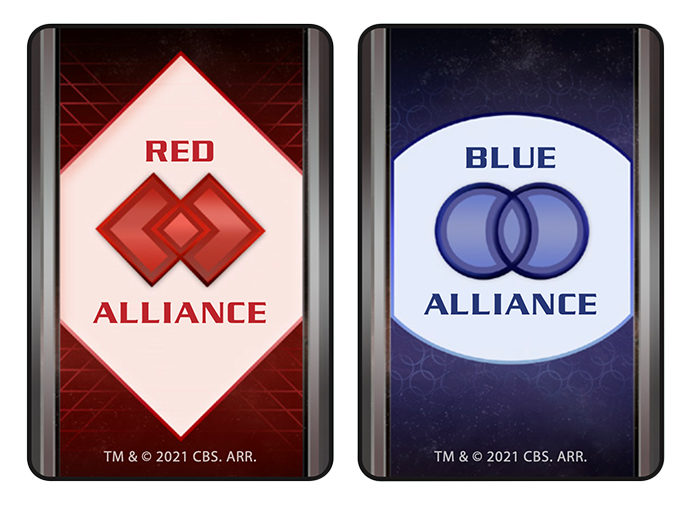 |
| Step 2. Build Your Civilizations |
Each player starts the game with their Home System connected to four explored and colonised Planetary Systems.
|
| Step 3. Connect Each Alliance |
Connect Each Alliance & Step 4. Connect the AdversariesNow, connect the Alliances. Each player creates a string of systems to connect with the player to their right. They keep rolling the Space Lane Dice and placing a new space lane connecting to a random, facedown System Disc with an Encounter Card, also facedown, . Until they can link their Home System to that player’s Home System.
|
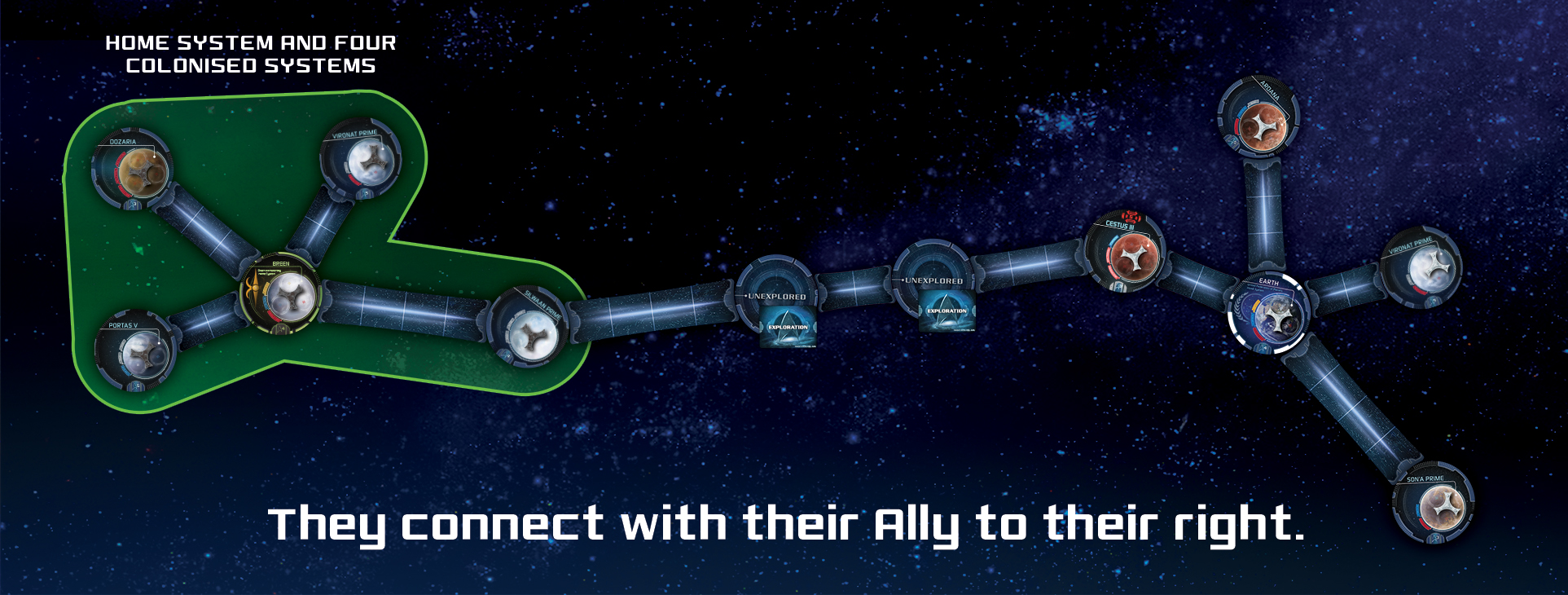 |
| Step 4. Building Nodes |
Each player now builds the three Resource Nodes on their Home System and nine additional Resource Nodes on adjacent Systems that they control.
|
| Step 5. Trade Agreements |
All players start the game having made contact and may exchange Trade Agreements with their Allies before the game begins. Each player can only hold one Trade Agreement at a time.
|
| Fleets and Starbases |
In this game players can have all three of their Fleets and all three of their Starbases in play regardless of Ascendancy level.
|
| Alliances and Allies |
You can enter or move through Sectors and Systems containing Allied Ships, and Form Fleets (but not Build Ships) at their Starbases. You can also Exhaust an additional Command Token when initiating a Space Battle to have Allied Fleets and Ships join in your Space Battles or Planetary Invasions.
|
| Alliance Cards |
Each Alliance has a deck of Alliance Cards that give bonuses to them or their Alliance as a whole. A player can only have up to three Alliance cards in effect or in their hand at any time, and draws two new ones each turn, so there’s no risk of running out.
|
| Conquest |
One of the biggest differences from normal is that you can’t be kicked out of the game. If an Adversary takes your Home System, it remains your Home System and you still control it. However, you are now at Peace with your Adversaries’ Alliance, and cannot attack them. The good news is that they can’t attack you or your planets either. Your conqueror levies a tax of half of everything you own or earn, can use all of your Advancements, and you must discard all Alliance cards and revoke all Trade Agreements with your Allies.
|
Things look bleak, but despite all that, you still play for your own Alliance. To help you fight back, you draw Resistance cards instead of Alliance cards.
|
The Conquered player must discard all Alliance Cards in their hand and that they have in play, and must revoke all Trade Agreements with their Allies. They cannot draw Alliance Cards or make Trade Agreements while Conquered. The Conquered player immediately draws a hand of three Resistance cards.
|
| Resistance |
Resistance cards allow you to fight back. Some of these allow you to sabotage your conqueror, steal resources from them, or secretly build extra ships. Others allow you to start an open rebellion. The dastardly rebels attack your conqueror, while you are still officially loyal to your new overlords so they can’t invade your planets.
|
| Liberation |
You don’t need to stay conquered. You can rebel if the conquering player ends their turn with three or fewer ships In Orbit of your Home System. In that case, if your rebels destroy all Adversary ships In Orbit you’re free. Alternatively, a member of your Alliance can liberate you by occupying your Home System. You are back in the game!
|